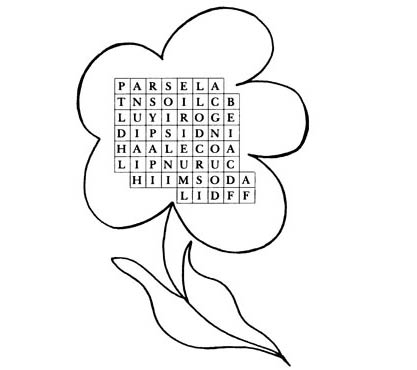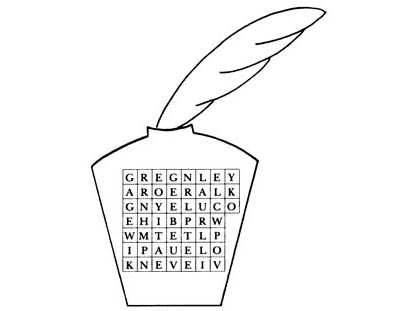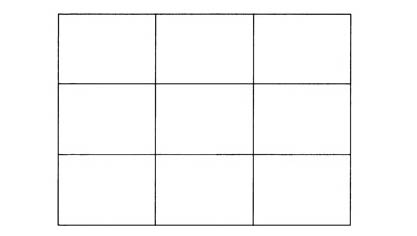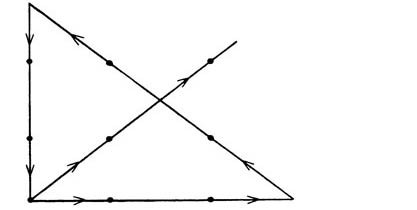Attention and Concentration
In order to develop and improve our memory, we simply have to develop our attention and concentration.
Most of the time, when we are doing ajob, our mind is on other things. We cannot remember, when reading, if we were thinking about the car or, when driving, if we were thinking about the dog or, when stroking the dog, whether we were thinking about work – while at work we only think about the holidays!
Attention and concentration are the mainstays of the memory. They are not only its tools but also its supports. But neither is inborn. We have to learn how to develop them.
The tests that follow in the chapter are geared to , the two great assistants of the memory.
READ TO RETAIN
This test requires all your attention. It consists of reading – at your normal speed without getting faster or slower – the following extract from Jamaica Inn by Daphne du Maurier.
Then answer the ten questions without looking at the text or the answers!
You have two minues to read the extract, which should allow you to run through it twice. Score two points for each correct answer.
Extract
The squire looked from one to the other in suspicion.
“What about you, Mrs Merlyn? Don’t you know where your husband keeps his keys?”
Aunt Patience shook her head. The squire snorted and turned on his heel. “Well, that’s easily settled,” he said. “We’ll have the door down in no time.” And he went out into the yard to call his servant. Mary patted her aunt’s hand, and drew her close.
“Try not to tremble so,” she whispered fiercely. “Anyone can see you have something to hide. Your only chance is to pretend you don’t mind, and that he can see anything in the house for all you care.”
In a few minutes Mr Bassat returned with the man Richards, who, grinning all over his face at the thought of destruction, carried an old bar he had found in the stable, and which he evidently intended using as a battering ram.
If it had not been for her aunt, Mary would have given herself up to events with some enjoyment. For the first time she would be permitted a view of the barred room. The fact that her aunt, and she too for that matter, would be implicated in any discovery that was made, caused her mixed feelings, however, and for the first time she realised that it was going to be a very difficult task to prove their complete and thorough innocence. No one was likely to believe protestations, with Aunt Patience fighting blindly on the landlord’s side.
It was with some excitement, then, that Mary watched Mr Bassat and his servant seize the bar between them and ram it against the lock of the door. For a few minutes it withstood them, and the sound of the blows echoed through the house. Then there was a splitting of wood and a crash, and the door gave way before them. Aunt Patience uttered a little cry of distress, and the squire pushed past her into the room. Richards leant on the bar, wiping the sweat from his forehead, and Mary could see through to the room over his shoulder. It was dark, of course; the barred windows with their lining of sack kept the light from penetrating the room.
Daphne du Maurier, Jamaica Inn
Questions
- What is the squire’s name?
- What was he looking for?
- What is the servant’s name?
- What was used to break down the door?
- Where was it found?
- Who went into the room first?
- What was Aunt Patience’s surname?
- Had Mary been in the room before?
- What was lining the barred windows?
- Whose side was Aunt Patience fighting on ?
Answers for evaluation
- Bassat
- The keys
- Richards
- An old bar
- In the stable
- The squire
- Merlyn
- No
- Sack
- The landlord
Answer analysis
- The fact that the order of questions does not stricdy follow that of the text is deliberate. This makes the test that litde bit harder.
- As you have no doubt already realised, memory cannot work without . Both are particularly important when you read something since, apart from the pleasure you may get from it, you never know what you might need – or be asked – to extract from it afterwards.
ATTEND TO YOUR READING
The text that follows is an extract from The Rainbow by D. H. Lawrence. Like the previous one, this test consists of reading the extract attentively and answering the questions.
Through concentration and attention you will master the art of making your reading more efficient. You will then have no difficulty in answering the questions which follow.
You have two minutes to read the extract. Score two points for each correct answer.
Extract
He went to wash himself. Queer little breaks of consciousness seemed to rise and burst like bubbles out of the depths of his stillness.
“It’s got to be done,” he said as he stooped to take the shirt out of the fender, “it’s got to be done, so why balk it?” And as he combed his hair before the mirror on the wall, he retorted to himself, superficially: “The woman’s not speechless dumb. She’s not clutterin’ at the nipple. She’s got the right to please herself, and displease whosoever she likes.”
This streak of commonsense carried him a little further.
“Did you want anything?” asked Tilly, suddenly appearing, having heard him speak. She stood watching him comb his fair beard. His eyes were calm and uninterrupted.
“Ay,” he said, “where have you put the scissors?”
She brought them to him, and stood watching as, chin forward, he trimmed his beard.
“Don’t go an’ crop yourself as if you was at a shearin’ contest,” she said, anxiously. He blew the fine-curled hair quickly off his lips.
He put on all clean clothes, folded his stock carefully, and donned his best coat. Then, being ready, as grey twilight was failing, he went across to the orchard to gather the daffodils. The wind was roaring in the apple-trees, the yellow flowers swayed violently up and down, he heard even the fine whisper of their spears as he stooped to break the flattened, brittle stems of the flowers.
“What’s to-do?” shouted a friend who met him as he left the garden gate.
“Bit of courtin’, like,” said Brangwen.
And Tilly, in a great state of trepidation and excitement, let the wind whisk her over the field to the big gate, whence she could watch him go.
He went up the hill and on towards the vicarage, the wind roaring through the hedges, whilst he tried to shelter his bunch of daffodils by his side. He did not think of anything, only knew that the wind was blowing.
Night was falling, the bare trees drummed and whistled. The vicar, he knew, would be in his study, the Polish woman in the kitchen, a comfortable room, with her child. In the darkest of twilight, he went through the gate and down the path where a few daffodils stooped in the wind, and shattered crocuses made a pale, colourless ravel.
D. H. Lawrence, The Rainbow
Questions
- What did Brangwen take out of the fender?
- Who suddenly appeared as he was talking to himself?
- What did she bring to him?
- What part of the day was it?
- Why did Brangwen go to the orchard?
- Who met him at the garden gate?
- Where was he heading towards?
- What was he thinking about?
- Who would be in the kitchen?
- What time of year was it?
Answers for evaluation
- His shirt
- Tilly
- Scissors
- Failing grey twilight
- To gather daffodils
- A friend
- The vicarage
- Nothing
- The Polish woman and her child
- Early spring
Answer analysis
- In a way this test presents less difficulty than the previous one, since the questions are asked in the order in which the detail appears in the extract. Moreover, the previous test was good practice and fixed the rules of the game in your mind.
- One slighdy different angle here is that some of the questions require greater attention to the general description than to particular facts – such as names. And the final question demands some deduction. The fact that the scene takes place in early spring can be deduced from the mention of daffodils and crocuses (obviously springtime), while the trees are still bare (therefore early).
- You should now know the difference between automatic and attentive reading. People who maintain that they do not remember what they read have most probably not learned to discipline their attention. Obviously one must exclude those problems of memory whose cause is pathological.
Remember
To make your reading active and positive:
- You must discipline your attention. Whether you are reading a book, an article in a newspaper or a prospectus, it is important to do so on the basis that you may well be required to answer some unexpected questions afterwards.
- Never remembering what you have read is rather like losing your glasses or keys. In effect, lack of attention damages the accuracy of our memories.
ONE WORD HIDES ANOTHER
Concentration requires effort. There are many who fail to fix their minds on a particular subject, an idea or a piece of work.
In order to concentrate, we have to respect a certain discipline in our behaviour. People talking nearby, music playing, the telephone ringing ... such distractions present major obstacles which we must look on as ‘aggressive’ towards concentration.
Sometimes we willingly let ourselves be distracted, notably when we are involved in some tedious work. In this case, we have to concentrate on our objectives and persuade ourselves that the end justifies the means.
This simple change of attitude will enable us to put concentration before anything else.
In the list of words below, the letters of each word can be written in a different order to form a new word. This new word can be any part of speech (noun, adjective, adverb, verb, etc.), but you must use all the letters in the first word.
Example: pale = plea, kiss = skis.
You have three minutes to find ten different words from the ones given in the list that follows. Score two points for each correct answer.
Practical tip
To remember someone’s name, you could make up an anagram that reflects, say, his business or occupation. For example, you meet a designer called Carter. The ideal anagram would be ‘Tracer’, since part of his work could involve tracing the oudines or details of images. Or take someone called Mr Shaw who runs a dry cleaning business. The perfect anagram here would be ‘Wash’. You can have a lot of fun making up your own, with names of people you come across.
Question
- PACE
- LACKS
- PIER
- MARE
- SUBTLE
- VEER
- PEAR
- GARDEN
- SAINT
- EVIL
Possible answers for evaluation
- cape
- slack
- ripe
- ream
- busde
- ever
- reap
- danger
- stain
- live
Answer analysis
- When you rearrange the letters of one word in a different order to create another, that word is known as an anagram. Not only do anagrams figure prominen-dy in cryptic crosswords, but they have been regularly used by novelists, particularly satirists, wishing to disguise references and, in some cases, avoid possible libel actions. One famous example is the political satire of Samuel Buder, which he entitled Erewhon -that is, Nowhere!
- For some of the words in this list there are, of course, alternative answers. For example, saint could also be satin and evil could equally be vile. For pear you could have put pare or rape. Naturally you should score full points for correct anagrams even if they do not appear in the list of answers given.
- Even though the words in this list were simple ones, you may have run out of time searching for alternatives. But do not be put off. If you try again, you will certainly come up with better results. Success in such mental gymnastics depends very much on your attention and concentration, but also on your willingness to invest the time to learn how to strengthen and develop your memory.
- To make up anagrams, you must not only look at the whole word but also dissect it and rearrange its parts. It is important to play around with the letters, making up different elements and juggling them about, breaking the word apart and leap-frogging letters and syllables. You must look at the word from every possible angle.
Remember
To find other possible words by rearranging the letters of existing ones:
- Concentrate and try to discover all the alternatives as quickly as possible, even those that seem improbable, in order to find one that makes a word.
- Do not persist with just one particular type of combination.
- Clear your mind and let your occupy the space.
HUNT THE ANAGRAM
This test is the same as the last one. It consists of rearranging the letters of each word in the list to make another word.
You have three minutes to find ten different words. Score two points for each correct answer.
Question
- MENTAL
- ULTIMATE
- REACTION
- DRAWER
- IGNITED
- DEBILE
- REGRADED
- ERASURES
- DENTIST
- RECANT
Possible answers for evaluation
- lament
- mutilate
- creation
- reward
- dieting
- edible
- regarded
- reassure
- stinted
- nectar
Answer analysis
- Thanks to the previous test, your brain’s mechanism knew how to work to make up anagrams from this list of words. Some were more difficult, others simple but perhaps not immediately obvious.
- As with the previous test, if you have found other anagrams which do not appear in the list of possible answers, score two points all the same – if they are real words, of course.
- Particularly with longer words, it is always a good idea to look for obvious groups of letters that make up starting or finishing syllables. Obvious examples here include re to begin a word and merit, ate, tion, ing and ed to end a word. Then it is just a question of rearranging the letters that still remain in order to find your anagram. Of course, such syllables will not always provide a solution, but they do act as a starting point if you cannot ‘see’ another word immediately.
Remember
To use your as effective tools:
- Do not keep worrying about the time limits given, but rather concentrate entirely on the objective. Probably the most apt quote here is from a nineteenth century French surgeon – one Dominique Larrey – whose main claim to fame is that he took four minutes to perform an amputation. He was quoted as saying: “Since we are in a hurry, let’s take our time.”
- Read each word quickly from left to right and then right to left. Repeat this, but jump over first one letter and then two in order to find the possible links or anchor points for rearranging the letters to give another word.
THE FLOWER MARKET
Crosswords, like Scrabble or other word games of the same sort, are exercises that can only help maintain a certain part of the memory.
The next test adopts a slightly different approach. You have to find the names of ten flowers hidden in the letter grid. All the letters that make up individual words are adjacent, either to one side or at an angle.
You may find the same word more than once, but you cannot use an individual letter twice for the same word. You can, however, use the same letter more than once if it fits into two different words. Do not be surprised if you don’t use all the letters.
You have ten minutes to find and write down the names of the ten flowers. Score two points for each correct answer.

Answers for evaluation
- Pansy
- Tulip
- Rose
- Dahlia
- Lilac
- Iris
- Begonia
- Delphinium
- Crocus
- Daffodil
Answer analysis
All the flowers to be found in this ‘market’ are common varieties. To make life a little easier, the key was to start in the top left-hand corner of the grid with the letter ‘P’. That is not to say, however, that you could not have made a start anywhere.
THE MULTI-COLOURED INK
This test works on the same principle as the last one. The object is always to teach you to move round the information in order to discover an organising principle which will help you to memorise.
You have ten minutes to find and write down the ten colours contained in the grid inside the inkpot pictured on the next page. Score two points for each correct answer.

Answers for evaluation
- Green
- Orange
- Grey
- White
- Mauve
- Pink
- Black
- Yellow
- Purple
- Violet
Answer analysis
As in the previous test, to make things easier you should have started in the top left-hand corner with the letter ‘G’ for green. But you could have started anywhere and still achieved the same result. Incidentally, no letter was used twice in this puzzle.
THE INFERNAL RECTANGLE
This test of attention, like the previous ones, requires organisation. How many rectangles can you count in the grid below?
You have three minutes to answer. Score 20 points for the right answer.

Answer for evaluation
36 rectangles
Answer analysis
To come up quickly and easily with the answer to this test, which is based on attention and organisation, you need to fully explore the resources of the diagram. It is therefore best to number each of the rectangles and use these to note all the possibilities.
Thus: There are 9 small rectangles inside the diagram. Plus the outer rectangle which encloses all of these. This makes 10. There remain 26 others, which should have been noted as follows: 123, 12, 23, 456, 45, 56, 789, 78, 89, 147, 14, 47, 258, 25, 58, 369, 36, 69, 123456, 456789, 124578, 1245, 4578, 235689, 2356, 5689. This gives you a total of 36.
LETTERS AND DOTS
The two exercises in that follow are very well-known. They involve the development of the right hemisphere of the brain.
1. There are lots of letters in the following grid and it would appear difficult to remember such a long list. However, there is a way of memorising them without having to learn them all.
|
R |
N |
N |
T |
O |
|
O |
G |
E |
H |
M |
|
L |
S |
S |
E |
O |
|
L |
T |
G |
R |
S |
|
I |
O |
A |
N |
S |
2. Join up the nine dots below using four straight lines without lifting your pencil off the paper and without passing through the same dot twice.
|
• |
• |
• |
|
• |
• |
• |
|
• |
• |
• |
Answers
1. “Rolling stones gather no moss”.
2.

Answer analysis
- From a very tender age, we have been taught to read horizontally from left to right. As a matter of cultural habit, there is an automatic tendency to try and tackle the exercise in this way. However, if we read vertically down each column starting on the left, we find the letters make up a well-known proverb: “Rolling stones gather no moss”. This is clearly much easier to remember than the letters which at first glance have no connecting organisation at all.
- To enlarge your vision, you must learn how to break free of any preconceived ideas and take a broader view. Then things which seem impossible while your vision is blinkered will become quite clear and simple.